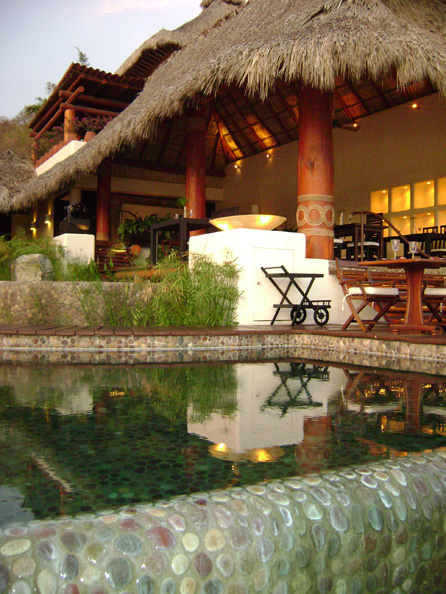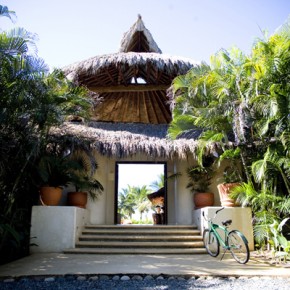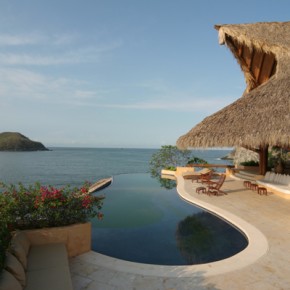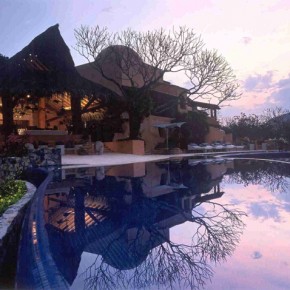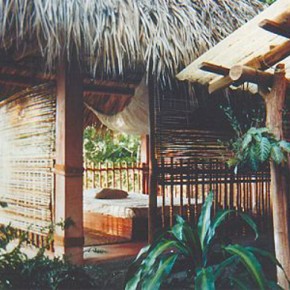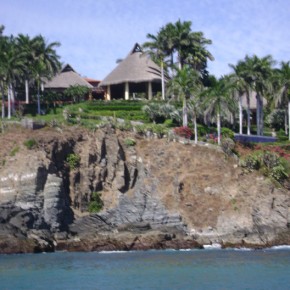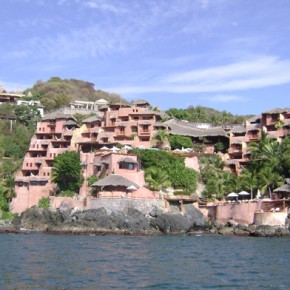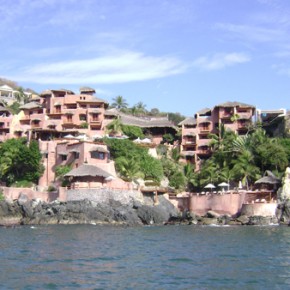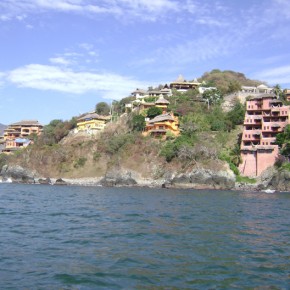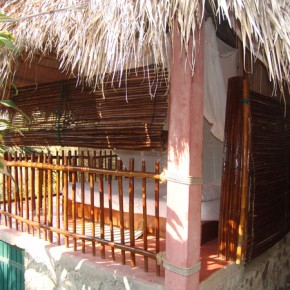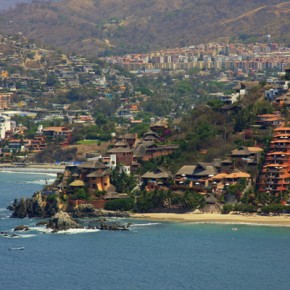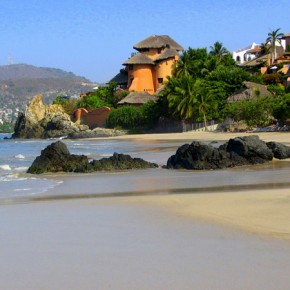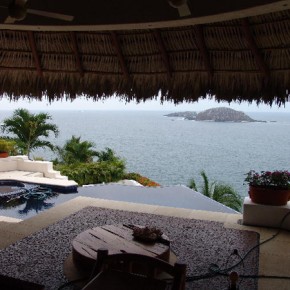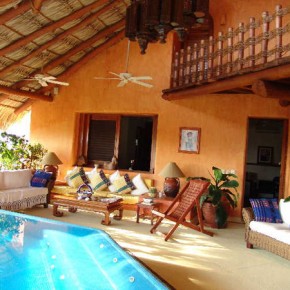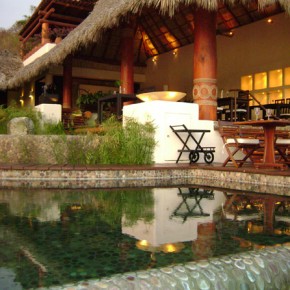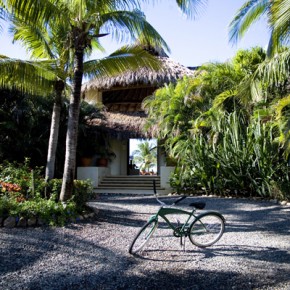In the 1960s and 1970s when Zihuatanejo first began to attract large amounts of foreign tourists, visitors would find themselves lodging in structures that were built with some combination of adobe, enjrejado (a wall’s skeleton is built with sticks and then filled in with mud and coconut shells, rocks, or other things), and/or huesito (the stem of a palm leaf), and sported Mexico’s authentic thatched palm palapa roofs. In these structures form followed function: they were open to the cooling breezes of the Pacific Coast unaided by fans or air conditioning, (as in many cases electricity was unavailable). And Ixtapa? There wasn’t much to it, Ixtapa was covered in trees and visitors to El Palmar beach played with the deer that wandered there. Today the modest guesthouses of Playa La Ropa have been replaced by (or in a few cases updated to) multi-million dollar hotels, inns, and residences that, to a great extent, carry on the logic of using local building materials and native housing styles. These logical climate-informed designs have shifted into a decorative and architectural technique that has increasingly come to define Zihuatanejo Style.
According to Nicole Dugal—a designer who first visited the area in 1972, and who since went on to create the design for La Casa Que Canta hotel, among other notable creations—this was how modern Zihuatanejo Style began. Not as the brain child of any one architect or by commission from a wealthy family looking for a second home, but in response to a way of life. A way of life that had people sleeping alfresco in hammocks or on petates (woven palm mats) during the hot siestas and slightly cooler nights. In the late sixties and early seventies, when foreigners began to take root on La Ropa Beach, this is where they dwelled: in spaces built with function, tropical weather, and local materials in mind more than rent-ability, fashion, and attention to stylistic detail. Dugal characterizes this way of building as a logical response to the “needs we have when living in this kind of weather. Much cooler is the thatched roof than the slab of cement enclosed with glass windows that turn the inside into a steam bath which has to be cooled with tons of air conditioning.”
The Zihuatanejo Style that is categorized by the look of the thatched roof and traditional way of building did not immediately take shape, however, as the bay was developed into a tourist destination. The first big projects were persuaded by “progress” to build with cement and glass, requiring a lot of air conditioning to keep the structures habitable. Hotel Sotavento, the first modern guesthouse built on La Ropa, was constructed in a rustic fashion, but with cement and a tile roof. The other hotels came later, building a “flashy cement construction,” as Dugal describes it. Throughout the 1970s and 1980s this type of modern construction prevailed and was defined by the use of cement walls, glass windows, and aluminum framing. Architects at this time were also taking to ignoring the area’s long-standing logic of orienting buildings according to what was known about the area and the weather (that storms come from the South, for example).
In 1972, Gloria Guinness commissioned the Sonoran architect Marco Aldaco to build a huge residence in Acapulco, which he designed to include a thatched palm roof. Dugal classifies this as the starting point for the return to constructing modern buildings in the traditional style of this region. The trend did not come to Zihuatanejo, however, until La Casa Que Canta was built in 1992—designed by Nicole Dugal, Enrique Zozoya, and Enrique Muller. This luxury hotel, “recouped the traditional way of living and the use of fine materials,” Dugal said, “…plus everything there is made by hand.” Zozoya and Muller went on to design other influential projects in the area, continuing with the use of the thatch roof look, if not the authentic roof itself. The taste for this style spread quickly, and soon buildings were being refurbished to match the trend. And now the style has spread outside the bay to Barra de Potosi, Saladitas, Troncones, and beyond.
Thatched palapa roofs are now also being used solely as decorative adornment, but this is the evolution of what was once a way of life. Dugal characterized this way of life in many ways. With rooms open to the outside, one can’t have bright lights or the bugs will be attracted. One must accept that when a home is open to elements, especially the humidity “all of your possessions will eventually be ruined”—though provided one has only what is needed to survive, as was also an aspect of this lifestyle, this isn’t actually a problem. Today however, the Zihuatanejo beach home builder is stylizing the architecture of this way of life without clients having to actually live the “way of life” that comes with it.
It is important to note that while the look of the thatched roof and authentic style has returned to popularity, it is not always accomplished by actually building in the traditional manner. The availability of amenities such as electricity, fans, and air conditioning have made it possible to combine luxury with the traditional look most easily identified by the thatched palm roof. Often there is a mix of the customary way of roofing a home and the more modern. At La Casa Que Canta hotel, though the building appears to be roofed completely in thatched palm, only the lobby is authentic thatch. The guest rooms are roofed in concrete but covered to give them the palapa look. Advancements in thatch roof technologies are also making them easier to rely on as they are being improved to be less likely to leak. Thus “true and authentic elements are being accommodated to modern life,” as Dugal put it. Dugal compares the stylization of authentic building traditions to similar trends in other industries. “I think something similar happened in fashion,” she says. “That which used to be the garment industry was suddenly revealed as the fashion world. The thatched huts became the fashionable beach residences,” and have come to define the architectural style here in Zihuatanejo.
Certainly not all the homes built in the area abide by the customary form-following -function principals — Zihuatanejo’s own Parthenon is a stark example of incongruity. It has, however, become the trend of the last decade and a half to build, or give the appearance of building, in this authentic way. This style has undoubtedly regained its popularity not because of a desire to return to the lifestyle originally associated with it, but a desire to imitate the authentic, traditional style of the region, as the city continues to grow.
-Originally Published in ADIP May/June 2008
- Villas Las Palmas Hotel, Photo by Jose Luis Castillo
- Enrique Zozaya property, Photo courtesy of Arq. Enrique Zozaya
- Enrique Zozaya property, Photo courtesy of Arq. Enrique Zozaya
- Casa de las Piedras, Photo by Grace Relfe
- Ixtapa home from the water, Photo by Catherine Krantz
- La Casa Que Canta Hotel, Photo by Catherine Krantz
- La Casa Que Canta Hotel, Photo by Catherine Krantz
- Bay front construction, Zihuatanejo, Photo by Catherine Krantz
- Casa de las Piedras, Photo by Grace Relfe
- Zihuatanejo Bay, Photo by Frank Sheppard
- La Casa Que Canta Hotel, Photo by Frank Sheppard
- Porto Ixtapa, Photo by Gloria Perez
- Villa Carolina B&B, Zihuatanejo, Photo by Gloria Perez
- Tentaciones Restaurant, Zihuatanejo, Photo by Gordon Krantz
- Hotel Las Palmas, designed by Enrique Zozaya, Photo by Jose Luis Castillo

